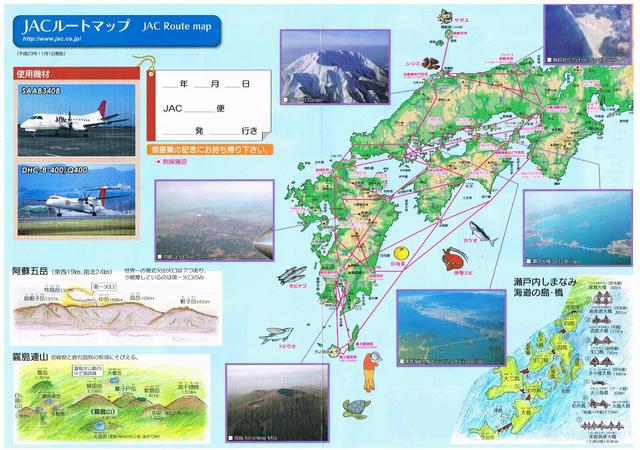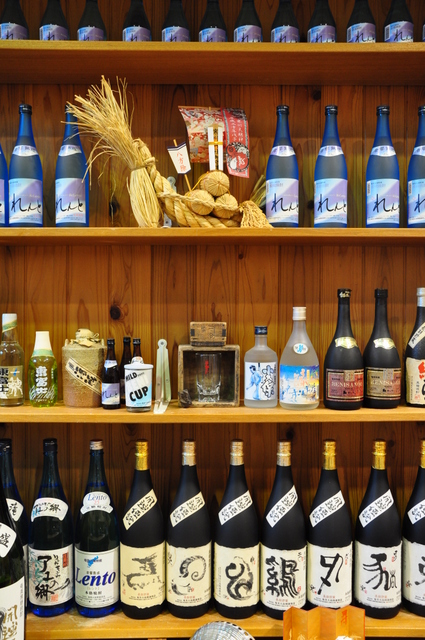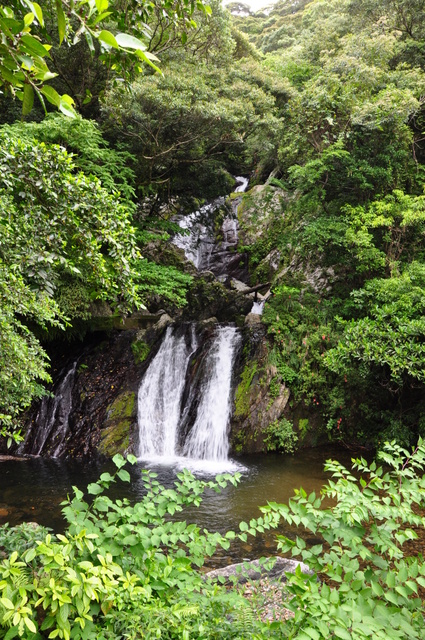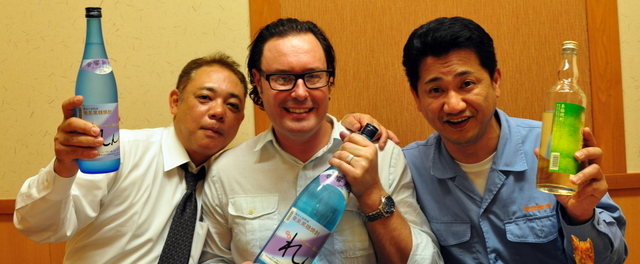Last issue my intrepid Japanese distributor, Horibuchi San and I started our southern Japan Sake soiree at Saito Shuzo in Kyoto, and then headed south to visit Hamada Shuzo in Kagoshima, the home of Kaido Imo Shochu. Our adventure continues as we travel further south to the Ryukyu Arc, a chain of islands that stretch southwest from Kyushu
“Does it have one propeller or two?” Horibuchi San and I have our faces plastered against the glass window overlooking the runway at Kagoshima airport. A wall of dark storm cloud gathers on the horizon as we contemplate our fate boarding a VERY small plane that will hopefully deliver us in one piece to our destination
Amami Oshima Kaiun Shuzo – Drink and luck will come
The Shochu gods smile upon us and deliver us safely (if not somewhat shaken) into the welcoming arms of the subtropical Amami Oshima, (pop. 66,000). This lush, mountainous Island is home to Amami Oshima Kaiun Shuzo, producers of ReLento, a premium Kokuto Shochu. We are greeted at the airport by Kaiun Director of Business, Mr Hironobu Tomari. I’m not sure if the paleness Horibuchi San and I were displaying was the result of our bumpy ride or the hospitality of Hamada Shuzo on the previous evening or possibly a combination of both. Either way, Tomari San decides we need a quick fix of the local chow. Turns out that our lunch, Kei Han is the ultimate hangover cure, a huge bowl of chicken broth accompanied by a plate of add-it-yourself condiments that consisted of shredded chicken, sliced egg omelette, spring onion, seasoned shitake mushroom, shredded seaweed, pickled ginger, dried orange peel and pickled papaya -available for take way too!
Fortified by the miracle broth, we make a slow, windy journey from the airport to the Kura. Life moves at a leisurely pace on Amami, I could almost swear the tachometer didn’t go over 40km, but hey; its Island time and I just need to adjust from the manic pace of Tokyo. Our scenic route enables Tomari San to give us the lowdown on the Island. Amami and seven other smaller Islands are a sub group of an island chain under the governance of the Kagoshima Prefecture on the mainland. Amami and the Okinawan islands in general have had quite a tumultuous history. From waring clan factions dominating rule up until the mid-1400’s, then invasion by the Tokugawa shogunate from the mainland in 1609, and the absorption into the mainland after the Meiji Restoration in 1879, then the subsequent American occupation until 1953. It’s enough to drive anyone to drink, and they did, finding comfort in local liquors produced from sugarcane.
The Amami Islands have 27 Shochu distilleries, of which 10 are situated on Amami Oshima itself. Demand for sugarcane now far outweighs the supply. Whilst traditionally the islands could provide enough sugarcane, the mountainous jungle and associated costs does make it problematic in cultivating large quantities of the sugar cane required for commercial production. Kaiun now look to Bolivia to supplement that supply. The Okinawans are no strangers to Bolivia with government encouragement of Japanese refugees since the 1930’s. Currently there are approximately 3000 Japanese nationals based in Bolivia and around 11,500 people of Japanese descent. Four years ago Kaiun Shuzo decided to invest in their own Bolivian sugarcane plantation to ensure supply and quality.
Before visiting the Kura proper Tomari San treats us to a peak at the water source for Kaiun Shuzo. We pull up to the most idyllic tropical waterfall one could imagine, if this is the source of their water then I’m thinking the end result cannot be anything but perfect.
The Kura is a short drive from the mountain stream, and we enter their main reception building that hosts an impressive display of the Kaiun Shuzo portfolio and other local produce. We get down to business. During the trip here I have badgered Tomari San with all sorts of obscure questions on the history of distillation in Japan and other such geekiness. He refers me to the “Shochu Professor”, Mr Naoshi Sugimoto, the local walking lexicon of Shochu knowledge who is happy to satisfy my curiosity. I am also introduced to Company President Senior Mr Hirofumi Watari. Watari San used to be in the hotel business, but in 1996 took a tree change and opened the distillery. Watari San’s pedigree as a Hotel operator shines through in the presentation of his distillery as I was soon to discover. Kaiun Shuzo is one of the most meticulously maintained and sparklingly clean distilleries I have ever seen, truly worthy of five stars!
Historically Shochu and Awamori distillation was mainly the domain of secret woman’s business, at home it was mum who looked after the home brew and this is still very much the case in the Ryukyu Islands today. In fact at Amami Oshima Kaiun Shuzo President Watari’s son’s wife is the head Toji. But it was very much a surprise wedding present, “Hi, welcome to the family, you are now going to train as our head brewer” And so the newly wed, Etsumi San was shipped off to brewery school in Kagoshima, most blokes couldn’t think of a better Honeymoon, I’m not sure if she felt the same…
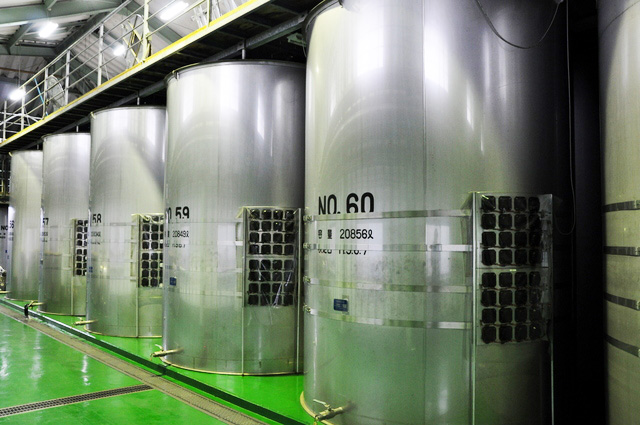
We tour the production facilities accompanied with a recap on Shochu distillation. First there is the moromi – Koji (Thai rice inoculated with the white mould – Aspergillus Kawachi), water and yeast. This mash kick starts the fermentation process, in laymen’s terms the koji converts the starch in rice to simple sugars and the yeast converts those sugars into alcohol. (Or Multiple Parallel Fermentation for you brewing geeks) Koji preparation takes approximately two days and the moromi ferments for 5 days. The moromi is then married with the raw brown sugar that has been liquefied. This marriage is generally done in 12000 litre tanks and the second stage fermentation takes approximately two weeks. Then we have the distillation, normally 10-12 hours for a 12000 litre batch. Distillation is done under vacuum where it can occur at lower temperatures (around 80 degrees) and evaporation/cooling done quickly to produce the smoothness required.

One striking element in the production of Relento would have to be the ageing. I was conscious throughout the brewery tour of a distant suggestion of classical music. The further we progressed down the production line and series of rooms the louder it became. All is revealed when we are greeted by the ageing tanks, wrapped around the waist of each tank is a girdle of speakers booming Beethoven’s 9th. My hosts are obviously enjoying my befuddlement and my raised eyebrow alone is enough to prompt an explanation. “We believe that the vibration caused through classical music assists the ageing process”. And who am I to argue such logic, in fact the products name Lento comes from the Italian musical terminology to describe a slow tempo (around 40-60 bmp to be precise). My mind wanders into a marketing frenzy – customised musical ageing, “Jeeves, bring me my Nirvana Nevermind aged Shochu thanks.”
Horibuchi san and I are treated to a tasting after the tour; Kaiun produces 7 products for the Japanese market but Lento is their export star. Its mellow flavour is reminiscent of sugar sweetness, accompanied by a rich fruity aroma. It has a solid female fan base; even the slender bottle lends itself to be gripped easier by smaller hands.
After a legendary night with the crew from Kaiun Shuzo, Horibuchi San and I are poured into another light aircraft and swiftly delivered to Ishigaki, (pop. 48,000) part of the Yaeyama Island group. We are pretty much at the end of the line; a few more Islands and the Philippine Sea are all that stands before us and Taiwan. Understandably, Ishigaki, like the rest of Okinawa takes cultural influences from Japan and China.
………………………………………………………………………………………………………………………………………………………………………
 Andre Bishop is a Melbourne based Sake Professional and is recognized as one of Australia’s leading authorities on Sake. His 12 years of experience in designing Asian and specifically Japanese venues include well know Melbourne establishments Robot Bar and Golden Monkey. He currently owns the 22 year old Japanese dining institution Izakaya Chuji and Sake Bar Nihonshu. He is also co-owner and founder of Melbourne’s flagship Izakaya and Sake Bar, Kumo in Brunswick East. Andre studied Sake in Japan and is the only Australian who currently holds a Level 2 Sake Professional Certificate from the International Sake Education Council.
Andre Bishop is a Melbourne based Sake Professional and is recognized as one of Australia’s leading authorities on Sake. His 12 years of experience in designing Asian and specifically Japanese venues include well know Melbourne establishments Robot Bar and Golden Monkey. He currently owns the 22 year old Japanese dining institution Izakaya Chuji and Sake Bar Nihonshu. He is also co-owner and founder of Melbourne’s flagship Izakaya and Sake Bar, Kumo in Brunswick East. Andre studied Sake in Japan and is the only Australian who currently holds a Level 2 Sake Professional Certificate from the International Sake Education Council.
Andre is available for Consulting on Sake, Japanese Beverage Lists, Sake Staff Training and Sake Equipment. Contact: andrebishopsan@gmail.com
Sake Master Andre’s blog: www.sakemaster.com.au
Twitter: sakemasterandre
Sipping with the Sake Master #6.2
Sipping with the Sake Master #6.1
Sipping with the Sake Master #5.2
Sipping with the Sake Master #5.1
Sipping with the Sake Master #4
Sipping with the Sake Master #3
Sipping with the Sake Master #2
Sipping with the Sake Master #1
Please click here for Sake Master Andre Bishop’s older interview



